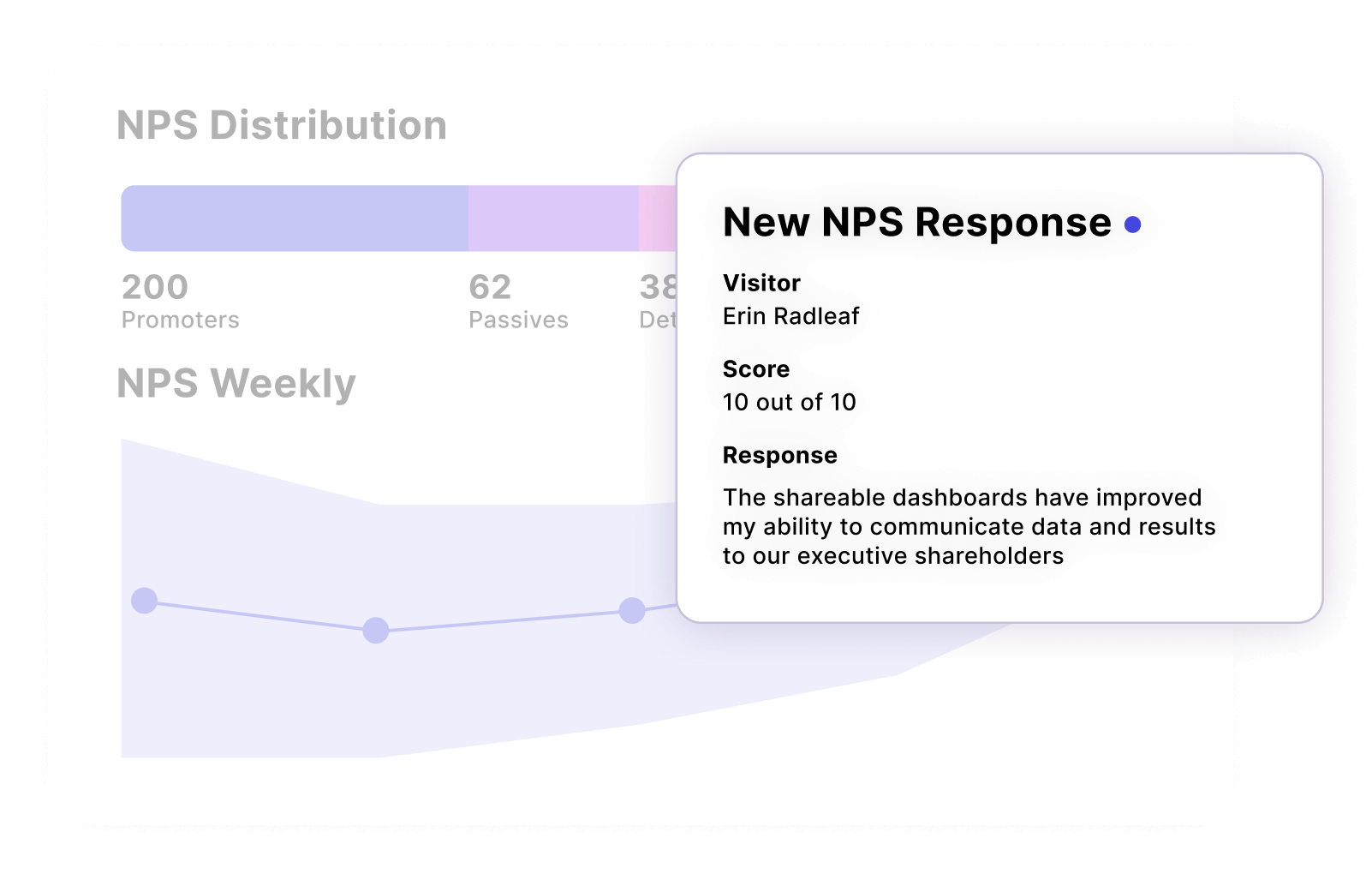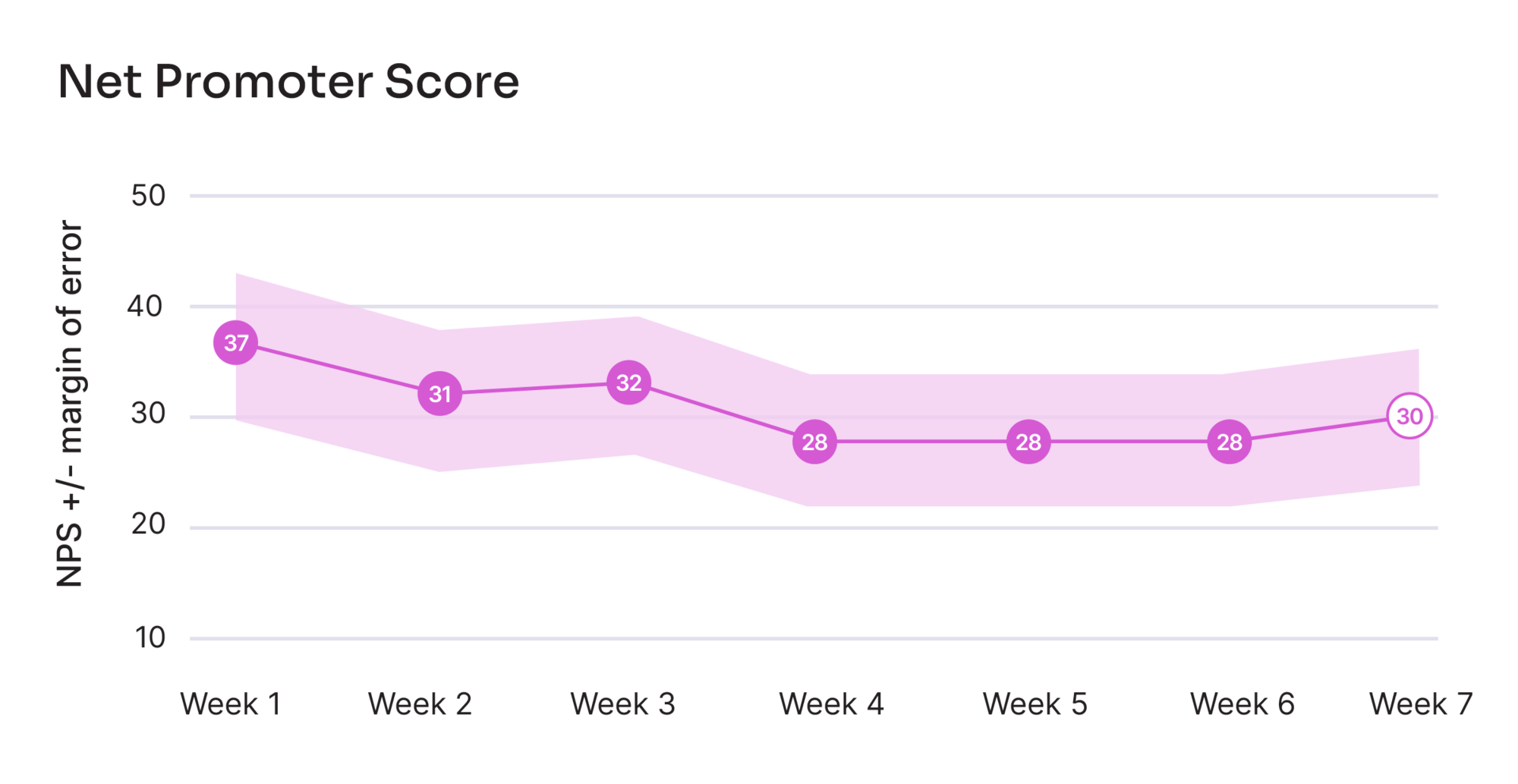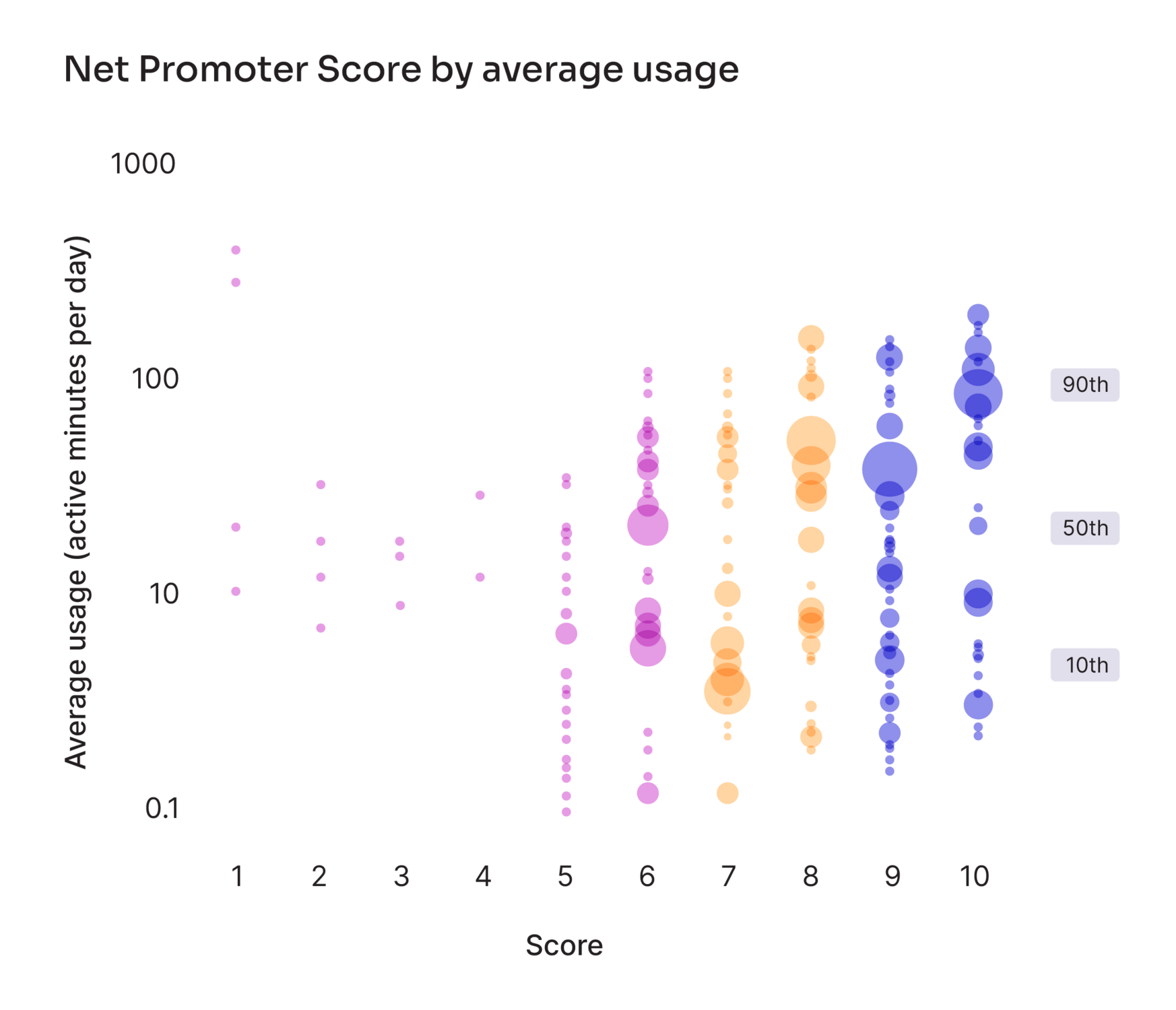
EIN UMFASSENDER LEITFADEN FÜR
Net Promoter Score (NPS)
Mit dieser Metrik wird die Neigung von Kunden, als Fürsprecher einer Marke aufzutreten, gemessen. Dies wiederum dient als Indikator für Kundenzufriedenheit und letztlich auch Unternehmenswachstum.
Tiefere Einblicke
Inhaltsverzeichnis
Was ist ein Net Promoter Score?
Der Net Promoter Score, auch NPS genannt, ist eine Metrik, welche die Neigung von Kunden, als Fürsprecher einer Marke aufzutreten, misst. Dies wiederum dient als Indikator für Kundenzufriedenheit und letztlich auch Unternehmenswachstum.
Because NPS reduces such a large question to a single-question (“How likely is it that you’d recommend this brand to a friend or colleague?”) survey with an answer limited to an 11-point (0-10) scale, many business leaders debate its merits. Despite grievances around oversimplification, NPS has emerged as one of the most pervasive KPIs for customer satisfaction in business today.
Wie lässt sich der Net Promoter Score berechnen?
Die Berechnung ist erwartungsgemäß einfach. Ein Unternehmen befragt seine Kunden mittels einer NPS-Umfrage. Dabei werden Kunden mit 9 oder 10 Punkten als „Befürworter“, mit 7 oder 8 Punkten als „Passiv“ und mit 0 bis 6 Punkten als „Kritiker“ eingestuft. Anschließend wird der Prozentsatz der Kritiker vom Prozentsatz der Befürworter abgezogen, um den Net Promoter Score zu erhalten.
Das ist die Formel für den Net Promoter Score:
Wenn ein Unternehmen mehr Kritiker als Befürworter hat, dann ist der NPS negativ. Dies ist natürlich nicht ideal, doch ein negativer NPS ist nicht unüblich. Da NPS-Werte je nach vertikalem Markt stark variieren, ist es für Unternehmen wichtig, sich mit den Konkurrenten zu benchmarken, die ihnen am ähnlichsten sind und für die sie Daten finden können. Für Unternehmen ist es außerdem von Bedeutung, sich mit sich selbst zu benchmarken, wodurch sie ihre eigene NPS-Entwicklung über einen bestimmten Zeitraum hinweg nachverfolgen können. Wenn es Unternehmen gelingt, veränderte Werte mit spezifischen Geschäftsereignissen wie Produktänderungen und Marketingkampagnen in Verbindung zu bringen, können sie besser nachvollziehen, welche Entwicklungen sich auf die Kundenzufriedenheit auswirken.
Die NPS-Berechnung im Zeitverlauf
Was ist ein guter Net Promoter Score?
Ein guter Net Promoter Score (NPS) variiert je nach Branche, aber im Allgemeinen ist ein Wert über 0 positiv und weist auf mehr Promotoren als Detraktoren hin. Werte über 50 sind ausgezeichnet und zeugen von einer starken Kundentreue, während Werte über 70 außergewöhnlich und selten sind.
Why NPS matters
Der Net Promoter Score (NPS) bietet mehr als nur eine Momentaufnahme der aktuellen Kundenstimmung – er ist ein aussagekräftiger Indikator für das zukünftige Geschäftspotenzial. Wenn Kunden Ihre Marke weiterempfehlen, spricht das Bände über ihre Zufriedenheit und Loyalität. Dies wirkt sich direkt auf Ihr langfristiges Wachstum aus. Es ist zwar verständlich, dass man sich auf die kurzfristige Steigerung des NPS konzentriert, doch ein konstant hoher NPS ist nicht nur eine Zahl, sondern ein Zeichen dafür, dass Ihre Marke einen loyalen Kundenstamm aufbaut, der zu nachhaltigem Erfolg führen kann. Denken Sie bei der Verbesserung Ihres Scores daran, dass der wahre Wert des NPS in der Möglichkeit liegt, langfristiges Geschäftswachstum vorherzusagen und zu fördern.
Was ist der Unterschied zwischen transaktionalen und relationalen NPS-Programmen?
Transactional NPS: Measures satisfaction after specific interactions, like purchases or support calls, offering immediate feedback on those experiences.
Relational NPS: Assesses overall customer loyalty periodically, providing insights into the long-term relationship and overall brand perception.
Wie sollte ich die NPS-Daten nutzen?
Nutzen Sie die NPS-Daten, um das Kundenfeedback zu analysieren, Kunden in Promotoren, Passive und Detraktoren zu unterteilen und diese Erkenntnisse in Ihr CRM zu integrieren. Dies hilft, Trends zu erkennen, die Abwanderung zu verringern, das Kundenerlebnis zu verbessern und Marketingmaßnahmen anzupassen.
For example: Use your product analytics tool like Pendo Analytics to plot account-level NPS against product usage and account size to determine which customers may be at the highest risk of churn.
Welche Best Practices gibt es bei NPS-Umfragen?
Fassen Sie sich kurz: Beschränken Sie die Umfrage auf das Wesentliche, um Umfragemüdigkeit zu vermeiden.
Sorgen Sie für ein optimales Timing: Senden Sie Umfragen kurz nach Interaktionen oder in regelmäßigen Abständen für einen relationalen NPS.
Reagieren Sie auf Feedback: Sprechen Sie mit Detraktoren, um Probleme anzusprechen, und danken Sie Promotoren für ihre Unterstützung.
Was ist der Employee Net Promoter Score (eNPS)?
Der Employee Net Promoter Score (eNPS) misst die Loyalität der Mitarbeiter, indem er sie fragt, wie wahrscheinlich es ist, dass sie ihren Arbeitsplatz einem Freund empfehlen. Er hilft bei der Messung der Mitarbeiterzufriedenheit und zeigt Bereiche auf, in denen das Unternehmen Verbesserungen vornehmen kann, um ein besseres Arbeitsumfeld zu schaffen.
Welche Faktoren wirken sich auf den Net Promoter Score eines Unternehmens aus?
Insbesondere für Softwareunternehmen ist es wichtig, den Unterschied zwischen NPS auf Kontoebene und NPS auf Nutzerebene zu verstehen. Letzterer erfasst den Wert der Person, die die Software regelmäßig verwendet. Da diese Person den direktesten Bezug zum Produkt hat, ist ihr Wert wahrscheinlich höher als der Kontowert. Letzterer ist aufgrund der weniger sachkundigen Perspektiven von Nutzern, deren Bezug zum Produkt nicht so direkt ist, weniger aussagekräftig.
Die Erfassung des NPS kann schnell komplex werden. Das Medium, durch das der Wert erfasst wird, kann ebenfalls die Ergebnisse beeinflussen. Eine NPS-Umfrage, die direkt im Produkt durchgeführt wird, führt voraussichtlich zu einem höheren Wert als eine E-Mail-Umfrage, da erstere eine höhere Anzahl an aktiven Nutzern mit direktem Bezug zum Produkt anspricht.
Dies soll nicht heißen, dass ein Nutzer-NPS oder In-App-NPS besser oder schlechter sind als ihre Gegenstücke. Es bedeutet lediglich, dass es hilfreich sein kann, sich über diese Einflüsse bewusst zu sein und beim Benchmarking über einen bestimmten Zeitraum hinweg konsistent zu bleiben.
The method of collecting survey data isn’t the only factor that impacts an NPS score. The buying experience, onboarding process, and, of course, the product itself all have the potential to create Detractors and Promoters alike. To this end, understanding which pages or features in the product increase customer satisfaction and guiding users to those features is one of the most reliable ways to improve NPS over time. For example, Cision Trendkite found that depth of use had a significant impact on customer satisfaction–their Promoters used a much larger set of features in the application compared to Detractors and Passives.
How to design effective NPS surveys
Designing an NPS survey is about more than asking one question. The way you word the question, when you deliver it, and how you follow up determines whether the Net Promoter Score (NPS) is meaningful or misleading. Strong survey design increases accuracy and makes results actionable.
Sample NPS survey questions (good vs. bad)
Strong NPS survey design starts with neutral, clear wording. Leading questions bias results and reduce reliability.
Strong Wording
- “On a scale from 0–10, how likely are you to recommend [Product] to a colleague or friend?”
- “Would you recommend us because we provide the best service?”
Weak Wording
- “How likely are you to recommend [Product] to others?”
- “How satisfied are you with our great software?”
Best practices for NPS survey questions:
Keep the core question short and neutral.
Pair the score with an open-text follow-up (“What is the main reason for your score?”).
Run surveys at relevant moments: after onboarding, following major updates, or on a quarterly cycle.
Pendo enables teams to launch in-app NPS surveys that appear in the context of the product experience. This improves response rates and ensures feedback reflects the user’s actual journey.
How to measure NPS
Choosing the right NPS software is critical for turning customer feedback into actionable insights. While many NPS tools collect survey responses, what differentiates the most effective tools comes down to connecting responses to product usage and customer outcomes.
Most NPS tools deliver surveys by email or SMS and provide dashboards for basic reporting. These approaches work for surface-level insights but often miss the context of when and where customers interact with your product.
Why Pendo stands out
Pendo approaches NPS differently by embedding surveys directly inside the product experience. This in-app delivery increases response rates and ensures feedback reflects the user’s actual journey.
Pendo’s NPS software also allows teams to:
- Segment responses by product usage, customer cohort, or account attributes.
- Combine NPS feedback with product analytics to identify what features promoters and detractors use most.
- Track changes over time to see how product improvements affect loyalty.
- Share insights across product, success, and leadership teams to drive coordinated action.
Because Pendo integrates NPS results with behavioral data, teams can answer deeper questions: Which features improve sentiment? Where do detractors struggle? How do promoters differ from passives in adoption? This transforms NPS from a survey into a customer loyalty metric tied directly to product strategy and growth.
Implementation checklist for NPS success
Implementing NPS requires a structured approach. A clear process ensures reliable results and actionable insights.
Before the survey
Define your goal: retention improvement, churn prevention, or referral tracking.
Choose the type of survey: relationship NPS (ongoing loyalty) or transactional NPS (event-based).
Select your channel: in-app (via Pendo) or external (email, SMS).
During the survey
- Write a neutral NPS question.
- Include an open-text follow-up to capture reasons.
Target the right audience: new customers, active users, or long-term accounts.
After collecting results
- Segment into Promoters, Passives, and Detractors.
- Share findings across product, customer success, and leadership.
Act quickly: thank promoters, address detractors, and analyze themes.
Pendo automates this process. In-app surveys deliver higher participation. Analytics dashboards reveal why scores shift. Segmentation ensures actions are targeted and measurable.
NPS and business outcomes
Net Promoter Score is more than a survey result. When managed correctly, it is a leading indicator of growth, retention, and product adoption. Unlike lagging financial metrics, NPS reveals customer sentiment early, giving teams the chance to act before outcomes show up in revenue.
Retention and churn
- Detractors (scores 0–6) often signal early churn risk.
- Identifying them quickly allows customer success teams to intervene.
- Promoters (scores 9–10) renew more frequently and are less price-sensitive.
Expansion and referrals
- Promoters are more likely to expand their product use and adopt new features.
- They also generate organic growth through referrals and word-of-mouth advocacy.
- In SaaS, this directly lowers customer acquisition costs and boosts account expansion.
Benchmarks and industry growth
Research from Bain & Company shows that loyalty leaders—companies with the highest NPS in their industries—grow at more than twice the rate of their competitors. This positions NPS not just as a measure of customer experience, but as a proxy for long-term business health.
Warum Pendo
Pendo connects NPS responses with product analytics, so organizations see why promoters or detractors feel the way they do. With in-app delivery, segmentation by behavior, and trend tracking over time, Pendo enables teams to:
- Correlate NPS with feature adoption and product usage.
- Prioritize roadmap decisions based on customer sentiment.
- Demonstrate how improving NPS links directly to churn reduction and revenue growth.
This integrated view transforms NPS from a score into a strategy for sustainable growth.
Wo kann ich mehr über Net Promoter Scores erfahren?
For those looking to dig a little deeper, there are a number of books on the subject, beginning with the one that started it all: Fred Reichheld’s “The Ultimate Question” (which is now available as a 2.0 edition) as well as free resources on how to improve NPS score. There are premium NPS analytics and insights solutions and free NPS survey tools available and any number of websites that publish NPS benchmarks by industry.





